
First Flights
This presentation contains actual pieces from each of the major first flights... from the Wright Brothers to Apollo 11. There is a piece of fabric from the first powered flight, the first flight across a continent, the first flight across an ocean, the first flight around the world, and the first flight to another worldThe creation of this presentation started with the acquisition of a piece of the original Wright Flyer's wing fabric. I acquired this rare piece of American flight history from Bill Whipkey. Bill worked for NASA during the golden age of space flight and was THE person many of the people within the space program went to in order to have presentations made of the items that were carried into space.

Anyone that collects space memorabilia is familiar with Mr Whipkey's presentations including such important pieces as the control handles from the Apollo 11 Command Module "Columbia". Above is cover, signed by the Apollo 11 astronauts, that has been passed around at various auctions from Aurora, to Astro-auction to eBay that clearly demonstrates that Bill had connections with the Apollo 11 astronauts... but, back to the Wright Flyer...

I spoke at length to Bill Whipkey about this artifact and this is what I found out...
This piece of fabric is from the Wright Flyer, the plane which made mankind's first powered flight.

After the flight of Apollo 11 Bill Whipkey was given a piece of fabric from the Wright Flyer, and from that piece, he assembled some presentations. Bill said that this piece, which I acquired from him, was a leftover piece, and that one of the Apollo 11 astronauts told him that he could keep it. Bill did not reveal the name of that astronaut to me because of "privacy concerns" and Bill could not verify one way or the other whether this item had been flown on Apollo 11 as "many years have gone by and I don't recall".
So, I had a bit of a mystery. I was fully aware that Neil Armstrong had taken a piece of the Wright Flyer with him on his historic mission to make the first lunar landing. I had heard that there was a piece of this fabric in at least two museums... the NASM in Washington DC and the Flight Museum in Ohio. I have never heard of an any item that Armstrong took to the Moon ever becoming available to purchase, nor was I aware that any of this fabric could ever become available for the public to purchase. But if it was... I couldn't think of a more significant piece of flight flown material.
I began my research into this piece by visiting Ken Hyde at his company headquarters "The Wright Experience" Ken and his team restore and replicate Wright Brothers aircraft. They built the replica Wright Flyer that flew at Kitty Hawk during the 100th anniversary celebration. Neil Armstrong was there at the event and helped Ken coordinate the reenactment of the First Flight. Ken learned from Neil that Neil Armstrong personally went to one of the members of the Wright family, before the flight of Apollo 11, to pick up the Wright Flyer fabric that he carried with him to the Moon.
Ken Hyde examined my piece of fabric by eye, by touch, with a magnifying glass and a microscope, and told me that without question it was an authentic piece of the Wright Flyer. AND... he pointed out something else.... that my piece was in PERFECT condition. He showed me the large piece of original fabric that he had there in his office that was on loan from the Wright family. It was soiled, dirty and tattered. From what I learned that day almost all of the Wright Flyers fabric was damaged in a flooded basement. Only a VERY small amount of the original fabric was stored elsewhere and had survived in mint condition.
I learned that the Wright family guards this material closely. That they will rarely gift a museum or charitable organization with a sampling... and even more rarely do they ever sell any... and never any of the pristine examples. Here's a sample of "gifting piece" which is valued in the 10k range (notice the fabric's soiled condition)...

I then went on to the National Air and Space Museum in Washington DC to continue my research. I found that currently there is a huge special exhibit set up displaying the Wright Flyer and showcasing many of the museums artifacts that relate to that famous First Flight. Inside one of the display cases was a large folded sampling of the Flyer's original fabric... stained, nearly brown in color. Yet over in the corner of the room, barely noticed by many of the museum's visitors was a small framed presentation that contained a piece of fabric from the Wright Flyer that was flown to the Moon on Apollo 11. The fabric looked fresh and new. I compared it to mine. They were identical.
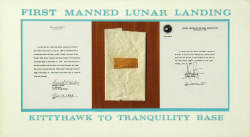
Accompanying the fabric was a letter by Neil Armstrong establishing that he carried it to the Moon with him on his voyage.

Based on my research I have no doubt whatsoever that this is an authentic piece of fabric from the Wright Flyer. It is rare piece and even rarer because of it's condition.
I also believe, but will probably never fully be able to prove, that it was carried to the surface of the Moon onboard Apollo 11 by Neil Armstrong. I have reached this conclusion due to:
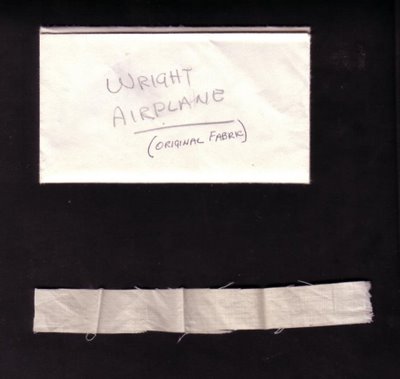
The fabric arrived to me in a plain, white, aged, envelope labeled "Wright Flyer". I wanted to present this piece a fitting manner but how? A few years ago an individual put together a lucite embedded piece known as "First Steps". I was very impressed with the piece... but I felt that it didn't go far enough.... that it should feature "First Flights". I also felt that the pieces should be large enough to appreciate... not just tiny specs. And I had some major concerns with making the presentation in a lucite block. The embeddment companies do not recommend embedding materials as delicate as fabric, that such materials can easily be damaged by the high temperatures that occur in the curing process and that sometimes this damage is not visible until years after the presentation is made. Also... once a piece of fabric is embedded in plastic... it always embedded, there is no hope for retrieval.
So I had my vision... a framed presentation featuring "Famous First Flights". I thought the concentration should be on goals of distance that were achieved, not speed, nor altitude. There would be the First Flight... ever, the First Flight across a continent, the First Flight across an ocean, the First Flight around the world, and the First Flight to another world.
The next three chronological First Flights were relatively easy to fill in as these pieces came from presentations produced by the Smithsonian Institute years ago. These three flights are often overlooked and generally unknown by the general public, but they each tell a significant story of determination and courage.
There was the Vin Fiz...

The first flight across the North American continent.


Which crashed many times along the way.
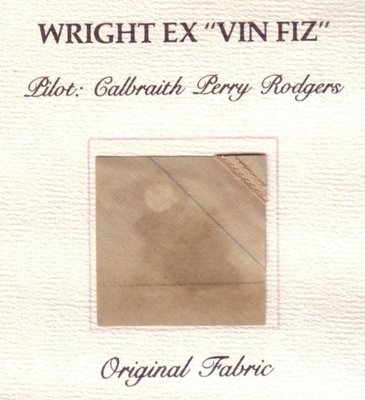
The Curtiss NC-4 which was the first plane to fly across the Atlantic... (no, The Spirit of Saint Louis was the first to fly with a solo pilot... the Curtiss, often overlooked, was the First)


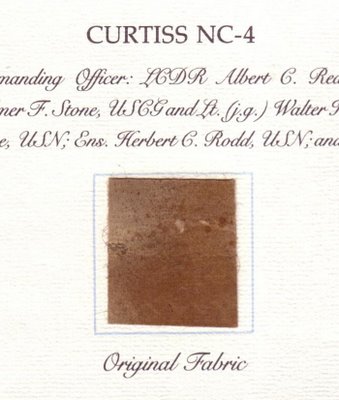
The "Chicago" was the first plane to fly around the globe. The flight of the "Chicago" is one of the great unknown stories of aviation... but what a great achievement... it's flight was followed closely by the world at that time.



And then Apollo 11 to end the series.


I selected this photograph of the Apollo 11 Command Module to be used in this presentation. I converted it to black and white to blend in better with the presentation. I sought out Ken Havecotte to supply a piece of Mylar skin from the capsule that you can plainly see peeling away in this photograph. Here is the presentation and mylar from Mr. Havecotte....
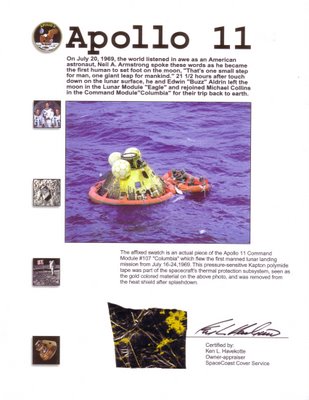
I had considered using material from Apollo 8 which was the first flight out to the Moon... but Apollo 8 didn't actually touch down there... sort of like Columbus venturing all the way to the New World and not sending a landing party to shore. Neil Armstrong has been quoted that it wasn't the first step that interested him... it was the first landing on the Moon that he felt was significant.
All in all I think that this presentation wraps up the story of first flights nicely, from a piece of a craft that made the very First Flight on this world, that was perhaps was carried on the craft that first flew to another world, of which there is a piece of that craft in this presentation too.

Anyone that collects space memorabilia is familiar with Mr Whipkey's presentations including such important pieces as the control handles from the Apollo 11 Command Module "Columbia". Above is cover, signed by the Apollo 11 astronauts, that has been passed around at various auctions from Aurora, to Astro-auction to eBay that clearly demonstrates that Bill had connections with the Apollo 11 astronauts... but, back to the Wright Flyer...

I spoke at length to Bill Whipkey about this artifact and this is what I found out...
This piece of fabric is from the Wright Flyer, the plane which made mankind's first powered flight.

After the flight of Apollo 11 Bill Whipkey was given a piece of fabric from the Wright Flyer, and from that piece, he assembled some presentations. Bill said that this piece, which I acquired from him, was a leftover piece, and that one of the Apollo 11 astronauts told him that he could keep it. Bill did not reveal the name of that astronaut to me because of "privacy concerns" and Bill could not verify one way or the other whether this item had been flown on Apollo 11 as "many years have gone by and I don't recall".
So, I had a bit of a mystery. I was fully aware that Neil Armstrong had taken a piece of the Wright Flyer with him on his historic mission to make the first lunar landing. I had heard that there was a piece of this fabric in at least two museums... the NASM in Washington DC and the Flight Museum in Ohio. I have never heard of an any item that Armstrong took to the Moon ever becoming available to purchase, nor was I aware that any of this fabric could ever become available for the public to purchase. But if it was... I couldn't think of a more significant piece of flight flown material.
I began my research into this piece by visiting Ken Hyde at his company headquarters "The Wright Experience" Ken and his team restore and replicate Wright Brothers aircraft. They built the replica Wright Flyer that flew at Kitty Hawk during the 100th anniversary celebration. Neil Armstrong was there at the event and helped Ken coordinate the reenactment of the First Flight. Ken learned from Neil that Neil Armstrong personally went to one of the members of the Wright family, before the flight of Apollo 11, to pick up the Wright Flyer fabric that he carried with him to the Moon.
Ken Hyde examined my piece of fabric by eye, by touch, with a magnifying glass and a microscope, and told me that without question it was an authentic piece of the Wright Flyer. AND... he pointed out something else.... that my piece was in PERFECT condition. He showed me the large piece of original fabric that he had there in his office that was on loan from the Wright family. It was soiled, dirty and tattered. From what I learned that day almost all of the Wright Flyers fabric was damaged in a flooded basement. Only a VERY small amount of the original fabric was stored elsewhere and had survived in mint condition.
I learned that the Wright family guards this material closely. That they will rarely gift a museum or charitable organization with a sampling... and even more rarely do they ever sell any... and never any of the pristine examples. Here's a sample of "gifting piece" which is valued in the 10k range (notice the fabric's soiled condition)...

I then went on to the National Air and Space Museum in Washington DC to continue my research. I found that currently there is a huge special exhibit set up displaying the Wright Flyer and showcasing many of the museums artifacts that relate to that famous First Flight. Inside one of the display cases was a large folded sampling of the Flyer's original fabric... stained, nearly brown in color. Yet over in the corner of the room, barely noticed by many of the museum's visitors was a small framed presentation that contained a piece of fabric from the Wright Flyer that was flown to the Moon on Apollo 11. The fabric looked fresh and new. I compared it to mine. They were identical.

Accompanying the fabric was a letter by Neil Armstrong establishing that he carried it to the Moon with him on his voyage.

Based on my research I have no doubt whatsoever that this is an authentic piece of fabric from the Wright Flyer. It is rare piece and even rarer because of it's condition.
I also believe, but will probably never fully be able to prove, that it was carried to the surface of the Moon onboard Apollo 11 by Neil Armstrong. I have reached this conclusion due to:
- the item's rare condition (only something as important as the first lunar flight could have pried a piece of this rare pristine material away from the Wright family),
- that this artifact came from an individual who assembled flown space item presentations,
- that this item came from an Apollo 11 astronaut after the Apollo 11 mission,
- that it came from a NASA employee (why else would NASA have a piece of the Wright Flyer?),
- and that it matches exactly the fabric that was carried to the Moon.

The fabric arrived to me in a plain, white, aged, envelope labeled "Wright Flyer". I wanted to present this piece a fitting manner but how? A few years ago an individual put together a lucite embedded piece known as "First Steps". I was very impressed with the piece... but I felt that it didn't go far enough.... that it should feature "First Flights". I also felt that the pieces should be large enough to appreciate... not just tiny specs. And I had some major concerns with making the presentation in a lucite block. The embeddment companies do not recommend embedding materials as delicate as fabric, that such materials can easily be damaged by the high temperatures that occur in the curing process and that sometimes this damage is not visible until years after the presentation is made. Also... once a piece of fabric is embedded in plastic... it always embedded, there is no hope for retrieval.
So I had my vision... a framed presentation featuring "Famous First Flights". I thought the concentration should be on goals of distance that were achieved, not speed, nor altitude. There would be the First Flight... ever, the First Flight across a continent, the First Flight across an ocean, the First Flight around the world, and the First Flight to another world.
The next three chronological First Flights were relatively easy to fill in as these pieces came from presentations produced by the Smithsonian Institute years ago. These three flights are often overlooked and generally unknown by the general public, but they each tell a significant story of determination and courage.
There was the Vin Fiz...

The first flight across the North American continent.


Which crashed many times along the way.

The Curtiss NC-4 which was the first plane to fly across the Atlantic... (no, The Spirit of Saint Louis was the first to fly with a solo pilot... the Curtiss, often overlooked, was the First)



The "Chicago" was the first plane to fly around the globe. The flight of the "Chicago" is one of the great unknown stories of aviation... but what a great achievement... it's flight was followed closely by the world at that time.



And then Apollo 11 to end the series.


I selected this photograph of the Apollo 11 Command Module to be used in this presentation. I converted it to black and white to blend in better with the presentation. I sought out Ken Havecotte to supply a piece of Mylar skin from the capsule that you can plainly see peeling away in this photograph. Here is the presentation and mylar from Mr. Havecotte....

I had considered using material from Apollo 8 which was the first flight out to the Moon... but Apollo 8 didn't actually touch down there... sort of like Columbus venturing all the way to the New World and not sending a landing party to shore. Neil Armstrong has been quoted that it wasn't the first step that interested him... it was the first landing on the Moon that he felt was significant.
All in all I think that this presentation wraps up the story of first flights nicely, from a piece of a craft that made the very First Flight on this world, that was perhaps was carried on the craft that first flew to another world, of which there is a piece of that craft in this presentation too.